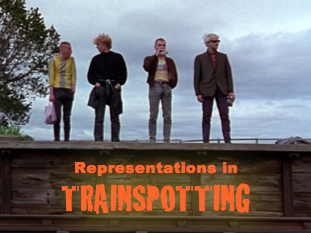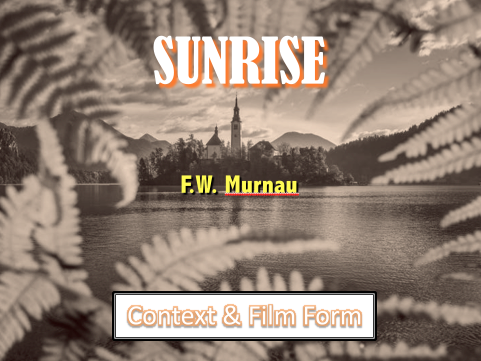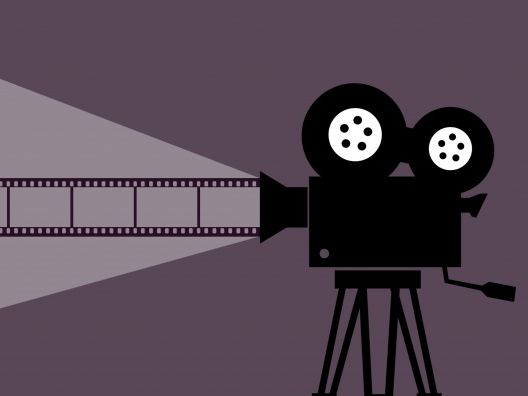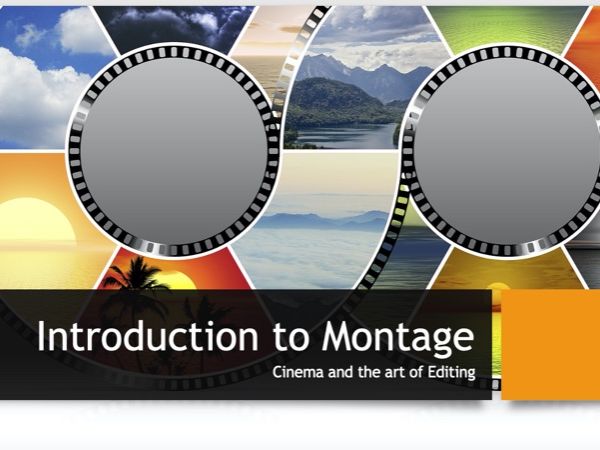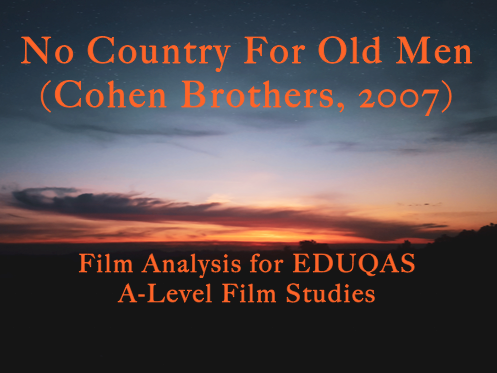60Uploads
15k+Views
2k+Downloads
All resources

REPRESENTATIONS IN *TRAINSPOTTING*
This is a set of notes to help for revision of TRAINSPOTTING for film studies A-Level candidates.
Representations analyzed include:
Nationality
Class
Gender
Age

EDUQAS FILM STUDIES A-Level - Silent Cinema Sunrise (F.W. Murnau)
This 39-slide fully interactive presentation ends with exam questions and guidance from the EDUQAS boards, as well as offering historical context and aesthetic characteristics of German Expressionist cinema, with special focus on SUNRISE (FW Murnau).
This presentation is excellent for exam revision and conveys the key talking points for this section of the **Film Studies **Component 2 paper.

Do Documentaries Tell Stories? - starter exercise
This is a quick starter worksheet to get students to begin a discussion on the similarities and differences between documentaries and narrative (fiction) films. They may be surprised how many conventions and techniques overlap. This can help to stimulate discussion of what makes a film a documentary, since documentaries can be harder to distinguish from narrative films than one might think.

Movie-Themed Treasure Hunt
This is an activity for team or pairs from Years 11+ and involves an active search for the answers, which are interdependent, so that one answer leads to another as students progress.
The game could be set up as a race to the finish line. Depending upon the research abilities and cinematic specialist knowledge of the team, the game could take anywhere from 15 minutes to 45 minutes to complete.
Included in this resource pack is: a treasure hunt ‚Äėmap‚Äô, two styles of answer sheets for students/teams, and an answer key for teachers.

Covid 19, Change and Technology: THE MACHINE STOPS
E.M. Forster’s 1909 short story about a future dystopia provides an excellent stiumlus to explore many issues that impact young peoples’ lives in 2021.
THE MACHINE STOPS (1909) paints a picture that allows us to reflect on a multitude of topical questions:
how far has technology helped us to advance, individually and socially?
how does technology impact our relationships to our bodies and senses?
how does technology affect our relationship with the natural world?
how do metaphor, irony and allegory work to convey social messages?
how does technology impact our ability to gain knowledge of what is true and to separate fact from fiction?
Forster‚Äôs prophetic short story was extremely prescient in its vision of a future society in which people would be confined indoors, socially distanced and isolated even from their closest kin, and in which all connection to people and the world is mediated through a ‚Äúmachine‚ÄĚ. What happens when Kuno decides he wants to escape the machine and to live by his own wits?

Cinema and the Art of EDITING
For both film and media studies, this 14-slide full colour, interactive PowerPoint presentation provides a brief introduction to the basics of film editing (montage).
The six elements of an edit are introduced, as well as a discussion of pace, style of editing and parallel editing (cross cutting).
Helpful links to YouTube videos provide illustrative examples of the terminology presented.
The Presentation - along with Q&A and examples - should fill a 1 hour lesson.

Post-Screening Discussion Questions - Film Studies - Raise the Red Lantern (1991)
**Raise the Red Lantern **(Dir. Zhang Yimou, 1991, China) is an excellent example of a film that deconstructs how
patriarchal power works and in this sense it is a film that is empowering for women, despite being a narrative *about *
disempowered women.
The film has also been discussed as a metaphor for Chinese state power and therefore also functions a a subversive political commentary.
With beautiful cinematography and composition throughout, this film is also a study in cinematic perfection, with mise-en-scene used to great symbolic effect. The film could be studied just as an excellent example of mise-en-scene.

Spectatorship Test
This 10 question test is a great accompaniment to the Specatatorship PowerPoint Presentation Resource for teaching the EDUQAS A-Level Film Studies Component 1, Section B. Contemporary American Film.
Topics covered include: hypodermic needle theory, active versus passive spectatorship, archetypes, intertextuality, viewing contexts, polysemy and oppositional readings of films.
The test is best used for Year 12 or Year 13 film studies but can also be helpful for Media Studies teachers vis-a-vis spectaorship and ideology.

SUNRISE (FW Murnau, 1927) -- Test
Basic Comprehension questions - Test - for SUNRISE, Eduqas A-Level Film Studies.

What is THE BECHDEL TEST?
A brief explanation of the Bechdel Test and what it measures. The test is widely regarded as a measure of female representation in film, and provides a useful ‚Äėrule‚Äô by which representation of women / girls can be measured.

Fish Tank (Andrea Arnold, UK, 2009) HOMEWORK QUESTIONS
Useful for the EDUQAS Film A-Level.
12 questions covering representations, class, ideology, narrative and ‚Äėthe female gaze‚Äô.

No Country For Old Men Analysis (A-Level Film & Media Studies)
This fully animated, interactive presentation is comprised of 43 full colour slides. The analysis of narrative, formal elements and spectatorship aims at preparing film studies students for the A-Level Exam, (EDUQAS FIlm Studies, Component 1B - American Cinema).
It is equally useful for any film or media course. Elements of narrative, as well as camera, sound design, mise-en-scene and lighting are all analysed in this comprehensive study of this modern Western gothic film.
This presentation is designed to form the basis for a full one hour lesson, and could be extended to further sessions.
Bundle

EDUQAS FILM Spectatorship Bundle
This collection of resources provides a range of
classroom ready resrouces to tackle the FIlm Studies A Level Component 1B. - Spectatorship Topic.
The Films referenced and used as examples include No Country for Old Men, Carol and Winter‚Äôs Bone. There is also an introductory PowerPoint with an overview of what examiners mean by ‚ÄėSpectatorship‚Äô and clear guidance on how to apply it to specific films.
There is a Test included as well.

TIMBUKTU - a film by Abderrahmane Sissako (2014)
This 40-slide full colour Power Point Presentation allows for a diverse range of topics to be studied. It covers history, culture, religious themes and filmmaking/media studies.
The film is about the destruction of culture and heritage, as well as occupation/colonialism, religious freedom, and human rights. The presentation also focuses on the film and its production, including representations and issues addressed by the filmmaker.
The film was produced to include the languages of the region in which it is set, including French, Tamasheq, English and other African dialects.
This resource facilitates rich discussion on topics such as: historical events, religious law, the value of cultural preservation and women’s rights.
It is appropriate for students aged 16 - 18. The violence of some events could be triggering for younger years.

EDUQAS A-Level Film Studies - introduction to SPECTATORSHIP Issues
This resource closely follows the EDUQAS A-Level specification and the Lisa Wardle textbook to offer teachers a comprehensive introduction to the main issues around spectatorship. This is especially useful in teaching Component 1, Section B, American Film Since 2005.
Topics covered include active versus passive spectatorship, viewer positioning, analysis of how film form and narrative shape spectator response, viewing contexts, demographic factors, intertextuality, preferred, negotiated and oppositional readings ( Stuart Hall’s theory) with a few case study application suggestions (CAROL, Haynes, 2015).
The resource includes interactive exercises and is presented with nice visuals and text/picture animations.
Approx length of time - 1 entire lesson (1 hour).
Number of slides: 38.

New Hollywood of the 1970s PowerPoint Presentation
This is a full color 20-slide presentation with links to helpful film clips as illustrations.
It forms a class lesson for A-Level film Studies or equivalent and gives helpful context for films produced at this exciting, director-led period of of Hollywood cinema.

Winter's Bone - binary analysis
This chart helps to understand how the narrative conflicts in Winter‚Äôs Bone are related to different ideological positions, with respect to values such as community versus individual rights, ‚Äėomerta‚Äô versus whistleblowing, and ‚Äėhonour‚Äô versus responsibility/ humanity.

Global Cinema Comparative Study: MUSTANG & TIMBUKTU
This 23 full colour slide presentation offers A-Level Film Studies Students many interactive exercises that will help them to compare and contrast these two films from global cinema. Mustang (Erguven, 2015, Turkey/France) tells the story of five sisters living in rural Turkey, where village and local Islamic traditions are still strictly enforced. Timbuktu (Sissako, 2014, Mauritania/France) dramatises the occupation of Northern Mali by Jihadist Islamists in 2012, and revolves around the real life story of a couple who were stoned to death for having a child out of wedlock.
The two films are studied as excellent examples of post-millennial global cinema and offer many points of comparison.
Both films offer means of studying religious debates, culture and global politics.
This presentation should fill an entire one hour lesson and may be extended into longer or more developed exercises.

Winter's Bone Ideology Graphic
This Graphic provides an overview of the key ideological issues for the film Winter‚Äôs Bone. There are other possibilities for the A-Level Film Studies Exam (such as gender or class) but this graphic provides possibly the best understanding of the more subtle political ideologies within the narrative and their contexts than the more ‚Äėidentity‚Äô based approach to ideology.
This graphic places the film within its concurrent social and political contexts, and these bear upon how the film will be** ‚Äėde-coded‚Äô** (vis. Stuart Hall‚Äôs theory) by viewers, depending upon the background knowledge they bring to their viewing experience. Therefore, this resource provides possibilities for** spectatorship issues** as well as ideology.

1970's - a decade of change
This 51-slide PowerPoint Presentation provides an overview of key events in the United States during the decade of the 1970s, including some 1960’s history to provide background context. The presentation covers political, social and cultural aspects of the era, including the civil rights and womens movements, anti-war protests, political scandals, anti-war agitation, and popular culture. This presentation gives students a feel for the historical climate that can provide excellent background context for novels, films and works of art from the period, as well as general history.
The presentation could provide a full lesson and may be used in tandem with study texts such as One Flew Over the Cuckoo’s Nest, The Post, Apocalypse Now, I Am Not Your Negro, Hamburger Hill, and many others…

